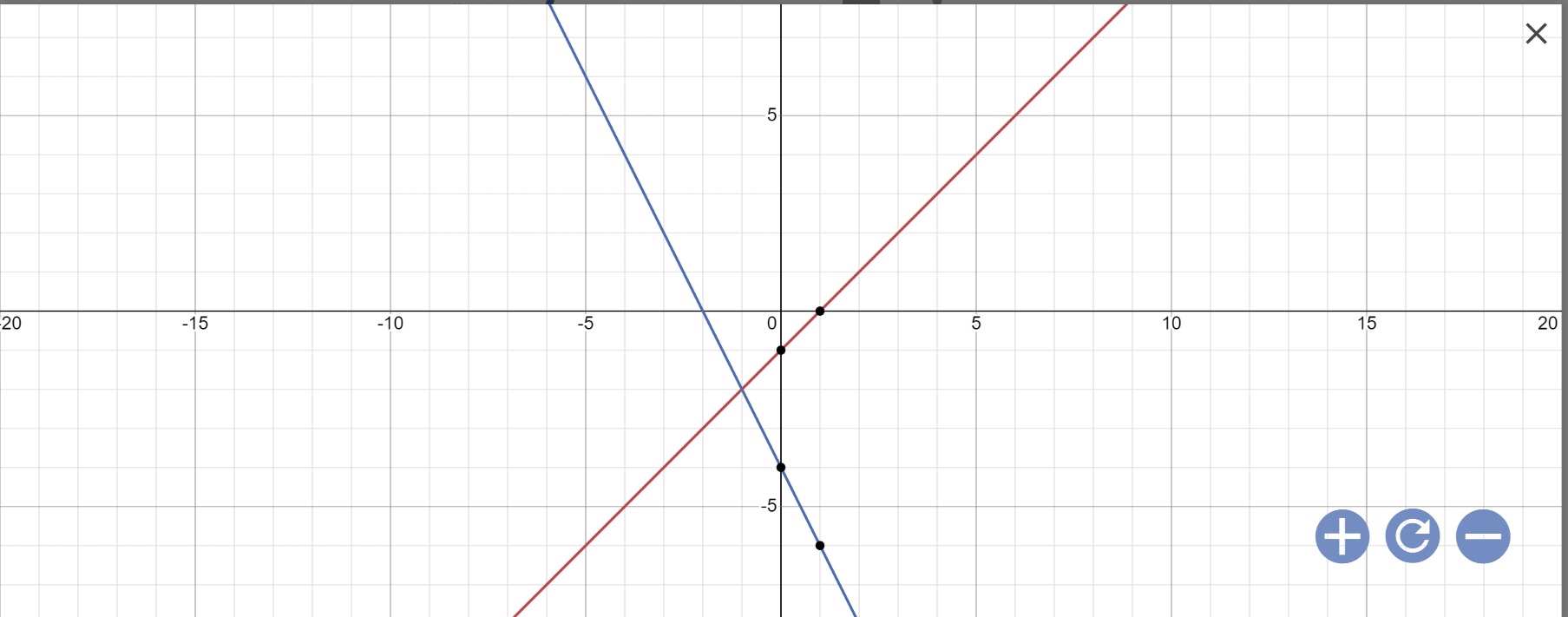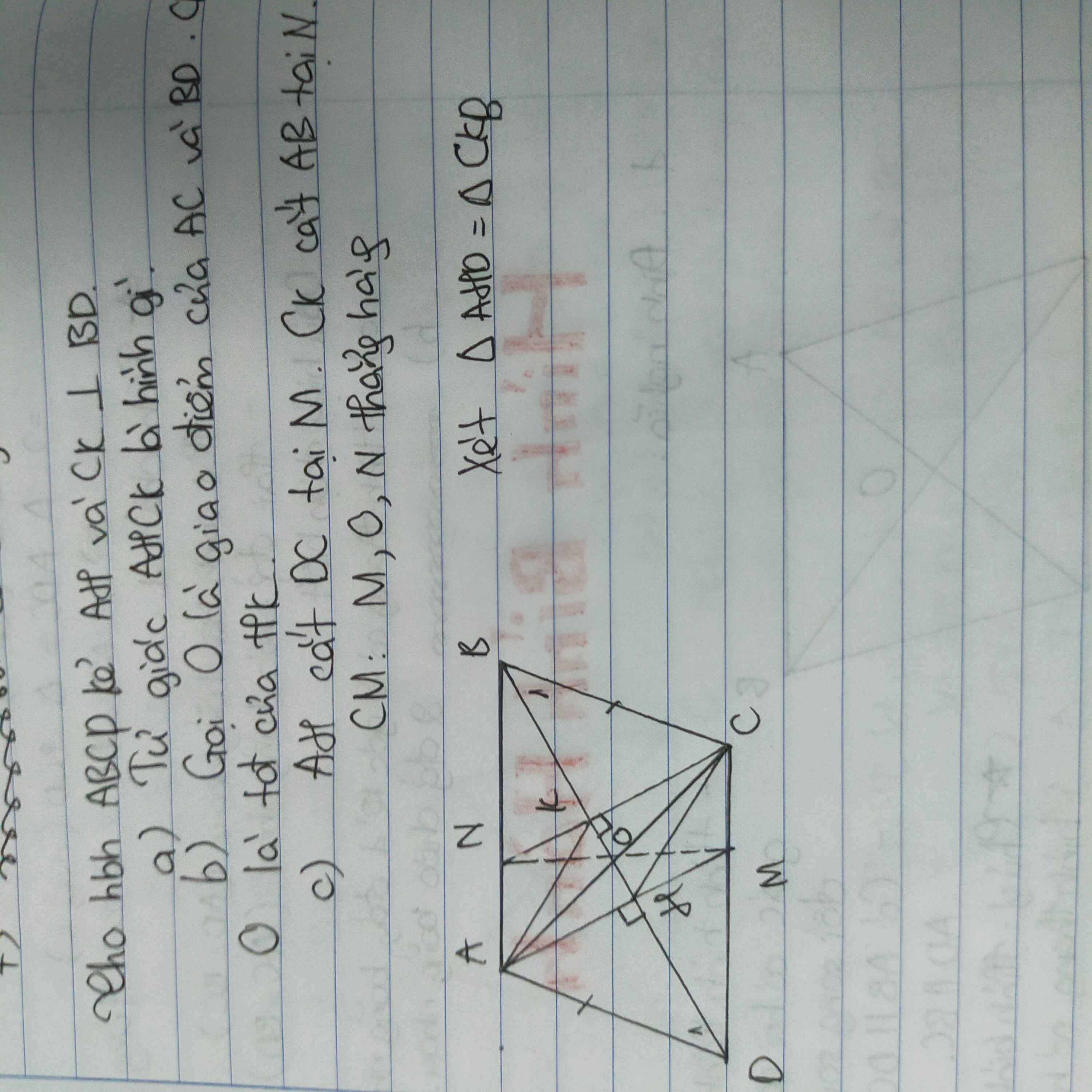
Hãy nhập câu hỏi của bạn vào đây, nếu là tài khoản VIP, bạn sẽ được ưu tiên trả lời.


a: Xét ΔAHD vuông tại H và ΔCKB vuông tại K có
AD=CB
\(\widehat{ADH}=\widehat{CBK}\)(hai góc so le trong, AD//CB)
Do đó: ΔAHD=ΔCKB
=>AH=CK
Ta có: AH\(\perp\)BD
CK\(\perp\)BD
Do đó: AH//CK
Xét tứ giác AHCK có
AH//CK
AH=CK
Do đó:AHCK là hình bình hành
b: ABCD là hình bình hành
=>AC cắt BD tại trung điểm của mỗi đường
=>O là trung điểm chung của AC và BD
ta có: AHCK là hình bình hành
=>AC cắt HK tại trung điểm của mỗi đường
mà O là trung điểm của AC
nên O là trung điểm của HK
c: Xét tứ giác AMCN có
AM//CN
AN//CM
Do đó: AMCN là hình bình hành
=>AC cắt MN tại trung điểm của mỗi đường
mà O là trung điểm của AC
nên O là trung điểm của MN
=>M,O,N thẳng hàng


Để hệ có nghiệm duy nhất thì \(\dfrac{a+1}{1}\ne\dfrac{-a}{a}=-1\)
=>\(a+1\ne-1\)
=>\(a\ne-2\)
\(\left\{{}\begin{matrix}\left(a+1\right)x-ay=5\\x+ay=a^2+4a\end{matrix}\right.\Leftrightarrow\left\{{}\begin{matrix}\left(a+1\right)x-ay+x+ay=5+a^2+4a\\x+ay=a^2+4a\end{matrix}\right.\)
=>\(\left\{{}\begin{matrix}x\left(a+2\right)=a^2+4a+5\\ay=a^2+4a-x\end{matrix}\right.\Leftrightarrow\left\{{}\begin{matrix}x=\dfrac{a^2+4a+5}{a+2}\\ay=a^2+4a-\dfrac{a^2+4a+5}{a+2}\end{matrix}\right.\)
=>\(\left\{{}\begin{matrix}x=\dfrac{a^2+4a+5}{a+2}\\ay=\dfrac{\left(a+2\right)\left(a^2+4a\right)-a^2-4a-5}{a+2}\end{matrix}\right.\)
=>\(\left\{{}\begin{matrix}x=\dfrac{a^2+4a+5}{a+2}\\y=\dfrac{a^3+4a^2+2a^2+8a-a^2-4a-5}{a\left(a+2\right)}=\dfrac{a^3+5a^2+4a-5}{a\left(a+2\right)}\end{matrix}\right.\)
Để x,y nguyên thì \(\left\{{}\begin{matrix}a^2+4a+5⋮a+2\\a^3+5a^2+4a-5⋮a^2+2a\end{matrix}\right.\)
=>\(\left\{{}\begin{matrix}a^2+4a+4+1⋮a+2\\a^3+5a^2+4a-5⋮a^2+2a\end{matrix}\right.\Leftrightarrow\left\{{}\begin{matrix}1⋮a+2\\a^3+5a^2+4a-5⋮a^2+2a\end{matrix}\right.\)
=>\(\left\{{}\begin{matrix}a+2\in\left\{1;-1\right\}\\a^3+5a^2+4a-5⋮a^2+2a\end{matrix}\right.\)
=>\(\left\{{}\begin{matrix}a\in\left\{-1;-3\right\}\\a^3+5a^2+4a-5⋮a^2+2a\end{matrix}\right.\Leftrightarrow a=-1\)

\(\left|\dfrac{4}{3}x-\dfrac{1}{4}\right|>=0\forall x\)
=>\(A=\left|\dfrac{4}{3}x-\dfrac{1}{4}\right|-\dfrac{2}{11}>=-\dfrac{2}{11}\forall x\)
Dấu '=' xảy ra khi \(\dfrac{4}{3}x-\dfrac{1}{4}=0\)
=>\(\dfrac{4}{3}x=\dfrac{1}{4}\)
=>\(x=\dfrac{1}{4}:\dfrac{4}{3}=\dfrac{3}{16}\)

a: 
b: Phương trình hoành độ giao điểm là:
-2x-4=x-1
=>-2x-x=-1+4
=>-3x=3
=>x=-1
Thay x=-1 vào y=x-1, ta được:
y=-1-1=-2
Vậy: Tọa độ giao điểm là A(-1;-2)

\(\left|6x+22\right|>=0\forall x;\left(y-21\right)^2>=0\forall y\)
Do đó: \(\left|6x+22\right|+\left(y-21\right)^2>=0\forall x,y\)
Dấu '=' xảy ra khi \(\left\{{}\begin{matrix}6x+22=0\\y-21=0\end{matrix}\right.\)
=>\(\left\{{}\begin{matrix}x=-\dfrac{11}{3}\\y=21\end{matrix}\right.\)

45:(3x-6)=5
=>3x-6=45:5=9
=>3x=9+6=15
=>\(x=\dfrac{15}{3}=5\)

\(\left(x^2+1\right)\left(x-1\right)=0\)
mà \(x^2+1>=1>0\forall x\)
nên x-1=0
=>x=1



Câu 8:
\(x:4\times36-x:7\times28+x:4\times20=180\)
=>9x-4x+5x=180
=>10x=180
=>x=180:10=18